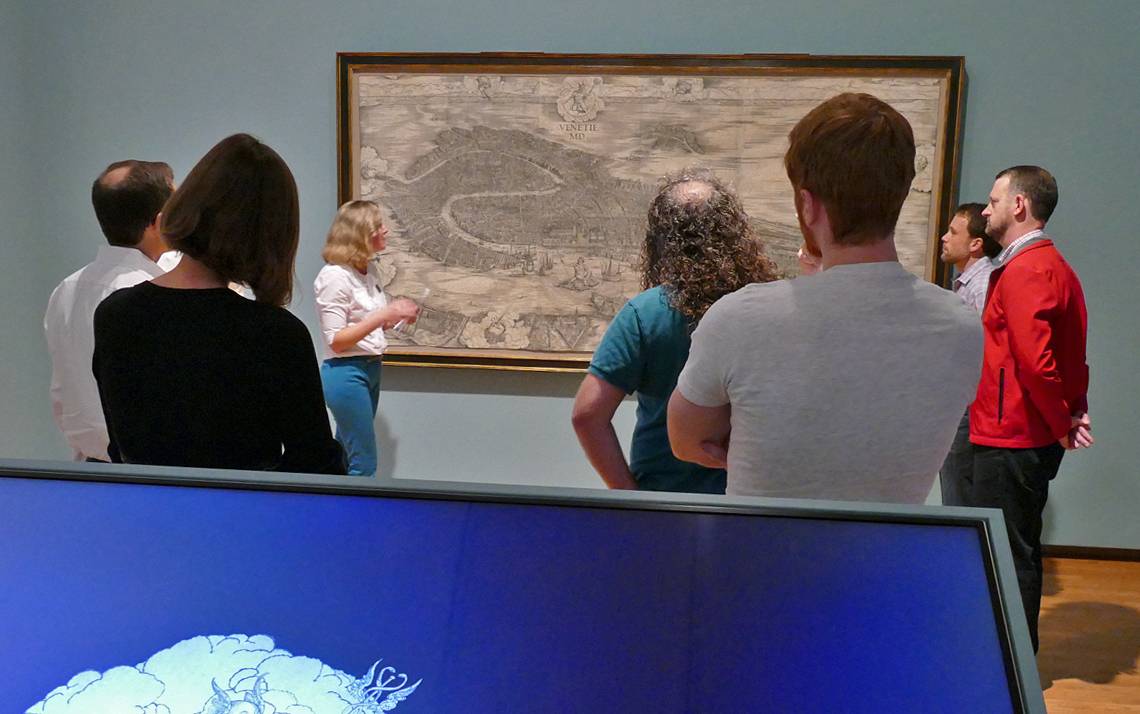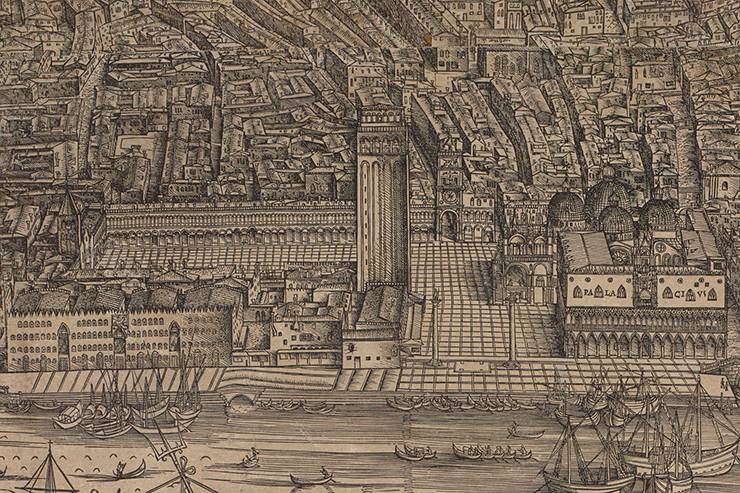An Exhibition of Teamwork
Pulling off Nasher Museum’s “A Portrait of Venice” exhibit required help from several corners at Duke

Seven years ago, Kristin Huffman was at a showing of Jacopo de’ Barbari’s View at the Minneapolis Institute of Art. The massive five-century old print shows an aerial view of Venice so detailed that visitors stood inches from the image, reveling in each tiny surprise.
They saw men digging for clams in the tidal flats of the lagoon and roses on the trellises in tucked-away gardens.
“There are just incredible little things that speak to the life of a city,” said Huffman, a scholar of Venetian art who is well aware image’s importance.
When Huffman, a lecturing fellow in Duke’s Department of Art, Art History and Visual Studies, got the Minneapolis Institute of Art to loan Duke the aerial view of Venice – one of just three versions in the country – she knew others would enjoy diving into the world the print unfurls.
But she knew making the exhibit happen would require some help.
Huffman, the exhibit’s curator, is quick to point out that, without the expertise of students, faculty and staff in several parts of Duke, “A Portrait of Venice: Jacopo de’ Barbari’s View of 1500,” – on display at the Nasher Museum of Art until December 31 – wouldn’t have become a reality.
“True collaboration is the conversations that happen in the hallway,” said Huffman, a member of Duke’s Wired! Lab for Digital Art History and Visual Culture. “It’s a ‘we’ve got this problem, how do we solve it?’ kind of thing. You come together.”
Months before the print – which is roughly four-feet tall and nine-feet wide – arrived in Durham, Huffman and her colleagues received a photographic image of it – which came in segments – from the Minneapolis Institute of Art. For a high-resolution, interactive version of the print, the photos needed to be scanned and stitched together.
For that, Huffman enlisted the help of Nevio Danelon, Ludovica Galeazzo and Ed Triplett, postdoctoral fellows in Art, Art History and Visual Studies, to find computer programs that were up to the challenge.
Once the hi-resolution image was created, the staff of the Duke Digital Repository, part of Duke Libraries, was able to use its resources to put it online for anyone to view.
“It’s a pretty astounding image,” said Will Sexton, head of digital curation services at Duke Libraries. “As we were working on it as a group, we just kind of fell in love with it. It’s a really beautiful piece.”
But the trickiest hurdle was finding technology that would allow Huffman’s vision for the exhibit to come to life.
Huffman reached out to Steve Toback and Richard Mitchell of the Academic Media Services team, which is part of the Office of Information Technology. They helped design the technological side of the museum installation and organize the workflow of the animation that, along with sound and interactive elements, brings the image to life.
“I’ve been at Duke for 10 years and this was one of the most fun and rewarding project I’ve worked on,” Toback said. “What made it fun wasn’t just the technology, it was that collaboration and being able to work with brilliant faculty and technology staff at the Nasher and the Wired Lab. We were just a team. It was such a great experience.”
The exhibit features a 79-inch, 4K resolution monitor with interactive elements and dramatic sound that gives viewers an animated exploration of the image. It’s ringed by smaller touchscreens that allow visitors to put the print in context by gliding through its depictions of life along the city’s canals.
And along the main wall is the print itself.
“It was really amazing to see everything come together in the space as we had been imagining it for so long,” said Hannah Jacobs, Digital Humanities Specialist with the Wired! Lab, who coordinated the team’s technical resources and coded several interactive displays.
The print’s exhibition at Duke has spun off other collaborative projects.
With help from the staff of the Innovation Co-Lab, models of some of the woodcuts the print came from are being created with 3-D printers. There are also plans to submit scans of the woodcuts to sophisticated data analysis, with the help of Duke Research Computing, to better understand how they were created.
“The collaboration has been one of the beauties of this particular project,” Huffman said. “People at Duke have been so generous.”